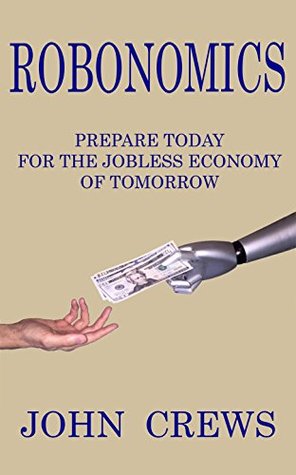Review: John Crews’s “Robonomics”
by Miles Raymer
In the last decade, the twin topics of technological unemployment and the automation revolution have found their way out of esoteric discussions between specialists and into the public consciousness. Plenty of good books are coming out every year to help us analyze these issues and gauge the degree of impact and pace at which they will reshape society. John Crews’s Robonomics is not one of them.
This dry, reductive text is one of the shortest pieces of nonfiction I’ve read in years, and it somehow managed to also be one of the most tiresome. Crews is so comfortable making blanket statements about the “inevitable” effects of automation that I was forced to conclude that he is either omniscient or woefully incapable of considering alternative points of view.
The fatal weakness here is not the substance of Crews’s predictions, many of which may very well come to pass. Rather, the problem is Crews’s tone––his insufferable and constant listing of events that “will” happen, paired with an inexplicable reluctance to employ less forceful but more responsible language. For a book about something as patently unpredictable as the future, Robonomics contains a startling dearth of tentative or qualified assertions.
I don’t have the time to decry each and every failing of this book, but here’s a brief (but by no means comprehensive) list:
- Crews thinks there is no moral problem with treating robots as slaves. He fails to address the question of whether robots will feel emotions or develop ideas/skills beyond exactly what we program. And yet he talks repeatedly about how intelligent they will be––enough to replace even the smartest humans in any workplace. He makes no attempt to explain how we are going to create entities with flexible, human-level intelligence that only think and feel exactly what we tell them to.
- Crews is adept at demonstrating how he thinks robots will take over existing forms of human labor, but makes little effort to imagine new forms of labor that might help humans achieve income-earning status in the future.
- Many of Crews’s ideas about the applicability of automation to education are laughable. He downplays the interpersonal and socioeconomic factors that largely determine a child’s ability to learn, and seems to think education is all about information transfer and test scores.
- Crews assures the reader that governments will institute a basic income for all citizens, but says nothing about how we can muster the political will to implement such a program in an era dominated by political gridlock.
- Crews paints sanguine pictures of a world where automation solves nearly all of humanity’s logistical problems, but ignores possible threats to automation infrastructure from widespread system failures, solar storms, and/or cybercrime.
- Crews doesn’t consider how climate change, ecosystem collapse, and/or advancements in sustainable living and energy production might spur or hinder the automation revolution.
In addition to these specific problems, there are also systemic flaws in Crews’s thinking. Many of Crews’s statements are so oversimplified that they might as well be lies. For example:
Being without a job does not mean being without income. Most Americans have some money in investments, some of which are quite sizable. Many people make sufficient income from their investments so that they do not have to rely on labor income; they can live off their investment income. (1527)
There isn’t anything in this passage that is downright false, but it’s a grossly deceptive characterization of how “many people” and “most Americans” live. What proportion of Americans does Crews think can truly “live off their investment income” alone? This view does not give credence to the darker side of an economy in which 44 percent of Americans can’t even come up with $400 to deal with an emergency––and that’s right now, without the further declines in human earning power that will occur as automation progresses.
In Crews’s estimation, those who don’t invest properly before the advent of full automation will have nothing beyond a meager basic income to keep them just above of the poverty line. Sustenance and entertainment will be ubiquitous and cheap, but opportunities for class mobility or personal advancement? You can forget about those––unless you have a trust fund.
I don’t know anything about Crews’s socioeconomic background or current status, but this attitude makes Robonomics feel like a book written by the 1 percent, for the 1 percent. Significant portions of the text are devoted to listing companies that will provide a good return on investment as automation ravages the laboring class. It’s hard to imagine an approach to this problem that would be more dull or less concerned with the greater good.
Futurists are often brushed off as nothing more than smug jerks who can’t see past their own small ideas of how the world must be. As someone with a deep respect for futurism and the cultural role of futurists, I am invested in combating this stereotype. But John Crews makes this a difficult task indeed. Technological unemployment and automation are complex, nuanced subjects that require complex, nuanced analysis. Robonomics doesn’t even come close to making the grade.
Rating: 2/10
